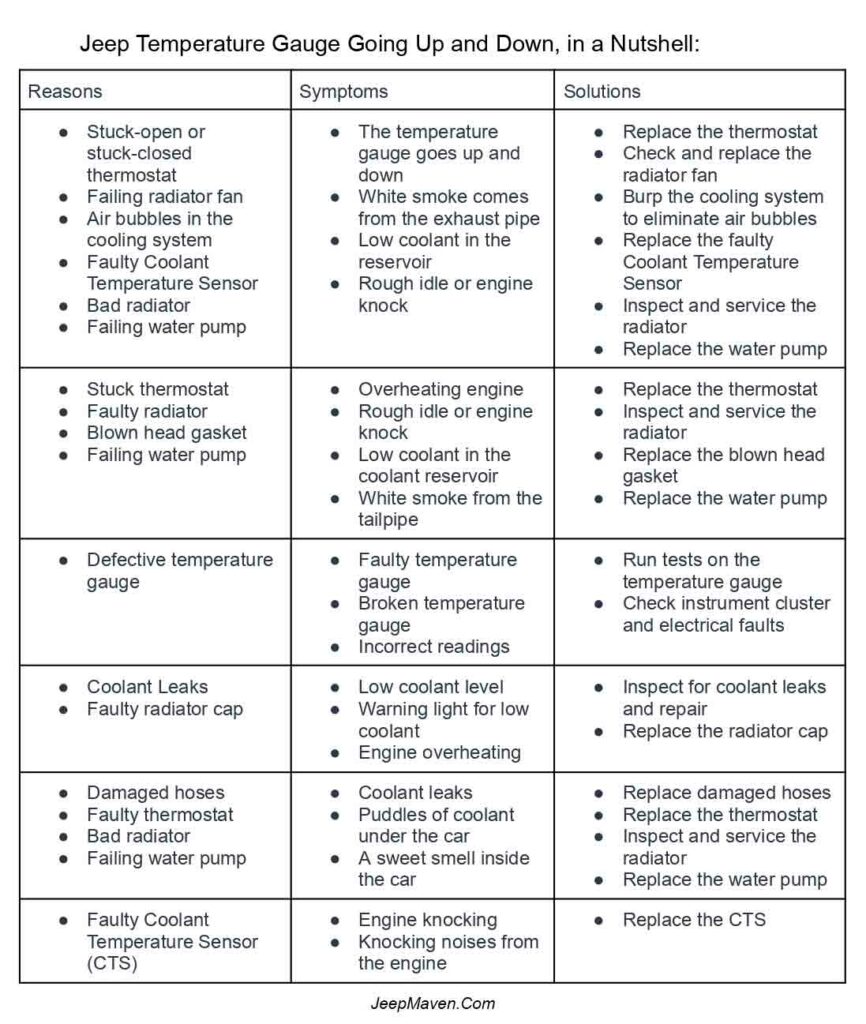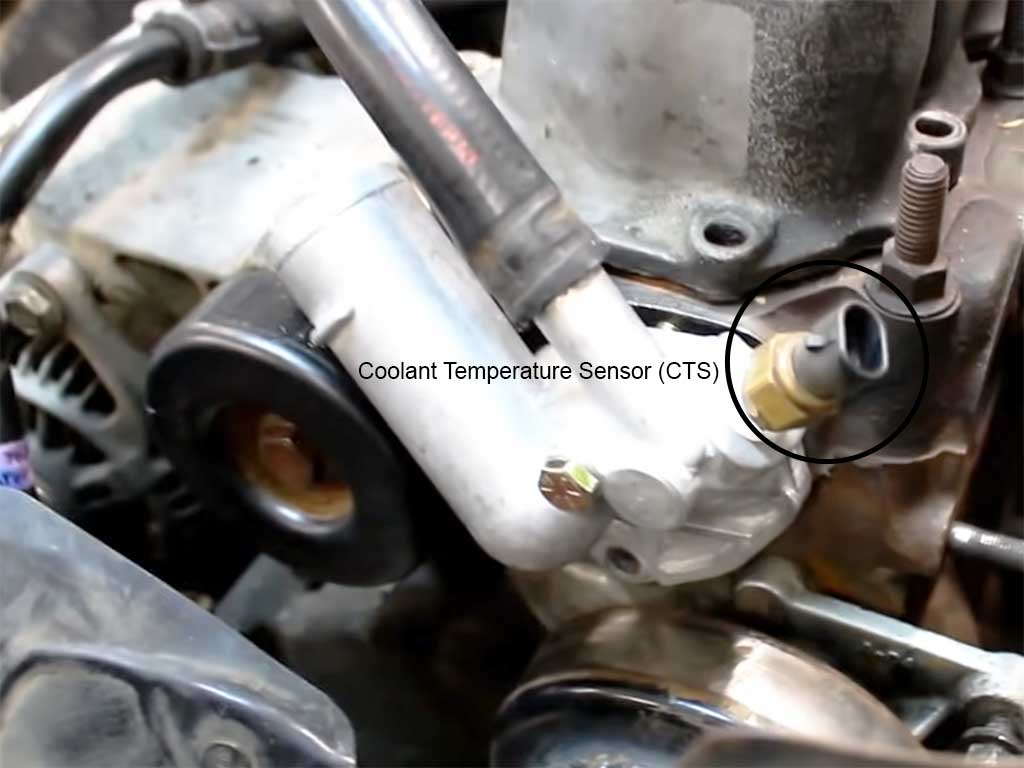Jeep Temperature Gauge Goes Up and Down: 8 Reasons And Their Fixes
When your Jeep’s temperature gauge goes up and down, it’s a sign of an underlying problem. The main culprits include a faulty thermostat, air bubbles in the cooling system, a misbehaving radiator fan, a leaky cylinder head gasket, or a defective gauge.
If your temperature gauge is acting up, how can you tell? Look for signs like odd fuel consumption, incorrect temperature readings, and strange black fumes from the tailpipe.
These are your engine’s way of saying, “Hey, something’s not right!”
In this article you’ll learn:
- Why does the Jeep temperature gauge go up and down
- The signs to watch for
- How to address the problem
- And more to come in the future…
From thermostat issues to potential cooling system glitches, I’ve got you covered.
Table of Contents
Why Does the Jeep Temperature Gauge Go Up and Down?
The Jeep temperature gauge going up and down problem directly relates to vital components.

Malfunctioning Thermostat
The thermostat in your Jeep is diligently monitoring the engine’s temperature.
It is orchestrating a delicate balance between 180 to 200 degrees Fahrenheit. When this component goes awry, your temperature gauge goes up and down while driving.
A malfunctioning thermostat can manifest in two ways. A thermostat stuck closed can cause overheating. Because it restricts the flow of coolant even when the temperature climbs.
Conversely, a thermostat stuck open prematurely releases coolant, keeping the engine cool and not letting it reach the ideal temperature.
Check for signs of leaking transmission fluid. It is a telltale sign of a faltering thermostat.
You can visually check or test the radiator cap to determine if the thermostat is stuck open or closed. The thermostat is stuck if the coolant doesn’t move after the allotted time.
Replace the thermostat to solve the issue. It’ll restore proper functionality to your engine’s temperature management.
To replace the thermostat, follow the steps below:
- Locate the thermostat within your engine.
- Use a bucket to collect the coolant from the thermostat.
- Remove the hose connected to the thermostat to prepare for a seamless transition.
- Inspect and install the new thermostat. Inspect the coolant’s height. Ensure that all elements are in sync.
- Flush out the old coolant before replacing it with the new coolant.
Leaking Cylinder Head Gasket
Overheating of the engine causes a head gasket to burst. The seal between the cylinder head and engine block gets damaged.
This leak combines coolant and oil, making them useless for lubricating and cooling the engine. It disrupts the delicate balance of coolant and oil and jeopardizes the engine’s structural integrity.
If you see white smoke emanating from the tailpipe, it signals the ominous presence of a blown head gasket.
Also, if your coolant disappears without visible leaks, it indicates potential head gasket failure. Identify the damaged head gasket and immediately replace it.
After the replacement, thoroughly bleed the oil and coolant to ensure the expulsion of the compromised mixture.
Air Bubble in the Cooling System
An often-overlooked culprit behind why the temperature gauge fluctuates is the presence of trapped air within the engine cooling system.
This occurs when air pockets reside inside the radiator. You may hear a distinctive bubbling sound resembling a waterfall.
Internal mechanisms are designed to expel these air pockets in Jeeps. But, occasional inefficiencies can result in the temperature gauge going up and down.
Trapped air within the radiator disrupts the normal circulation of coolant. It causes temperature irregularities.
Your engine may overheat when idle, or cool down when the vehicle resumes motion. The temperature gauge reflects this turbulence by going up and down.
To fix the situation, you need to burp the system. Remove the radiator cap and elevate the vehicle’s front section on a ramp.
Start your Jeep and let it idle. Squeeze the radiator hose a few times as the engine heats up. Listen for a burping sound indicating the release of air. Replace the radiator cap and drive the vehicle to see if the problem is still present.
If the problem persists, investigate potential underlying issues such as a defective radiator cap, blown head gasket, or radiator hose leaks.
If you address these issues, it may resolve persistent air bubble problems.
You can also bleed the cooling system. Remove the radiator cap, fill it with coolant, and start the engine.
Turn the heat high with the fan on low, topping off the coolant as levels drop. Loosen bleed valves, rev the engine, and continue this process until temperature fluctuations stop.
Faulty Coolant Temperature Sensor
A malfunctioning Coolant Temperature Sensor (CTS) can significantly contribute to the Jeep temperature gauge going up and down.
Located within the engine, this sensor may become contaminated, damaged, or corroded, leading to inaccurate temperature signals.
When the CTS fails, it can cause the temperature gauge needle to exhibit fluctuating movements.

To address this issue, conduct diagnostic testing using an OBD2 scanner. Allow 20 minutes for your engine to cool before starting any diagnostic or replacement steps.
For easier access, jack up the front of your vehicle. Remove the radiator cap. Drain the coolant or water from the radiator to prepare for sensor replacement.
Properly disconnect the CTS wiring connector. Remove the faulty temperature sensor using a ratchet. Install the new sensor securely. Reattach the wiring connector.
Start your engine to check if the temperature gauge now provides stable and accurate readings.
The cost of replacing a faulty Coolant Temperature Sensor ranges between $200 and $450. It covers the price of the sensor and associated labor costs.
Radiator Fan Failure
The radiator fan is positioned near the reservoir tank. It serves a vital role in regulating engine temperature.
Its responsibility is to draw air through the radiator when the vehicle moves at insufficient speeds for natural airflow.
A malfunctioning radiator fan disrupts this process. Then, the Jeep temperature gauge goes up and down.
If your Jeep temperature gauge is fluctuating, the problem may be caused by a faulty radiator fan.
Inefficient cooling due to the malfunction can result in engine overheating. It can cause permanent damage.
To address this issue, consider swift replacement of the faulty radiator fan. It’ll restore efficient engine cooling and prevent further complications.
Maintain consistent temperature regulation and avoid escalated repair costs down the line.
Bad Radiator
If your Jeep temperature gauge goes up and down, a malfunctioning radiator may be at the core of the issue.
When the radiator fails to effectively regulate coolant temperature, the engine can overheat. Common issues contributing to this problem include a broken fan, a bad radiator, or a faulty radiator cap.
Sludges forming in the radiator indicate a deteriorating radiator that requires immediate replacement.
A rusty color in the coolant signifies inefficiency. An engine may overheat if a compromised radiator is used for extended periods.
An improperly sealed radiator cap allows air to penetrate the radiator, creating air pockets in the heater core and radiator hoses. This can lead to unstable coolant temperatures throughout the engine, causing overheating.
Symptoms that may point to radiator issues include increased temperature while idling, a change in coolant color, symptoms of a failing radiator cap like an overflowing coolant reservoir or leakage, and other signs such as decreased engine power, strange noises, and faulty thermostat readings.
To address these issues, replace the radiator if sludges are present or the coolant changes color.
An aluminum radiator is a durable alternative with corrosion resistance and excellent heat output.
Check the radiator cap for proper sealing. Replace it if signs of failure are present.
Flushing the radiator with vinegar can effectively remove debris and residue if it is clogged, rusty, or leaking.
Follow specific steps. Raise the vehicle. Drain the coolant. Flush with a vinegar-water mixture.
Failing Water Pump
If you have a failing water pump, your Jeep temperature gauge can go up and down.
The water pump moves coolant via the radiator and engine. When it fails, coolant circulation diminishes. It leads to rapid heating and potential overheating.
Watch out for symptoms like coolant leaks, audible whining noises, and a sudden increase in your temperature gauge. These are indicators of potential water pump issues.
To address these issues, inspect for coolant leaks, listen for whining noises, and monitor your temperature gauge.
If you detect symptoms of a water pump failure, take prompt action. Check the serpentine belt and replace the water pump if necessary.
Regularly inspect your water pump, address coolant leaks, and replace promptly when needed to maintain a reliable cooling system.
Faulty Temperature Gauge
If you find yourself with a Jeep temperature gauge that goes up and down, although unlikely, the cause may be a faulty temperature gauge.
Whether it’s a flaw in a new car straight from the manufacturer or wear and tear in your aging vehicle, a malfunctioning temperature gauge renders your gauge unreliable.
The symptoms manifest as inconsistent readings, with the temperature gauge fluctuating from normal to cold, signaling an impending problem.
Other electrical faults may extend beyond the temperature gauge, affecting various gauges within the instrument cluster.
Run diagnostic tests to thoroughly examine the temperature gauge to address this issue. Determine if it is indeed the source of the problem. Gauge problems could indicate broader electrical faults.
Consider the Electronic Control Unit (ECU) as a potential contributor to gauge irregularities, especially if anomalies appear in other gauges within the instrument cluster.
Read More:
- ABS, ESP, BAS, And Traction Control Lights On? Learn 6 Causes And Their Fixes!
- Jeep Commander Transmission Over Temp Problem: How To Fix? [Solved]
Final Words
If the temperature gauge goes up and down in your Jeep, don’t ignore it, as it can lead to severe consequences, including engine failure, ultimately leading to substantial repair costs for the engine.
To avoid potential engine damage, take proactive steps when you observe your Jeep’s temperature gauge going up and down. This includes thoroughly inspecting failing signs and promptly replacing any defective components.
Whether it’s a faulty radiator, defective water pump, coolant leakage, or a problematic thermostat, addressing these issues promptly ensures a smoother performance and safeguards your engine from more severe consequences.
